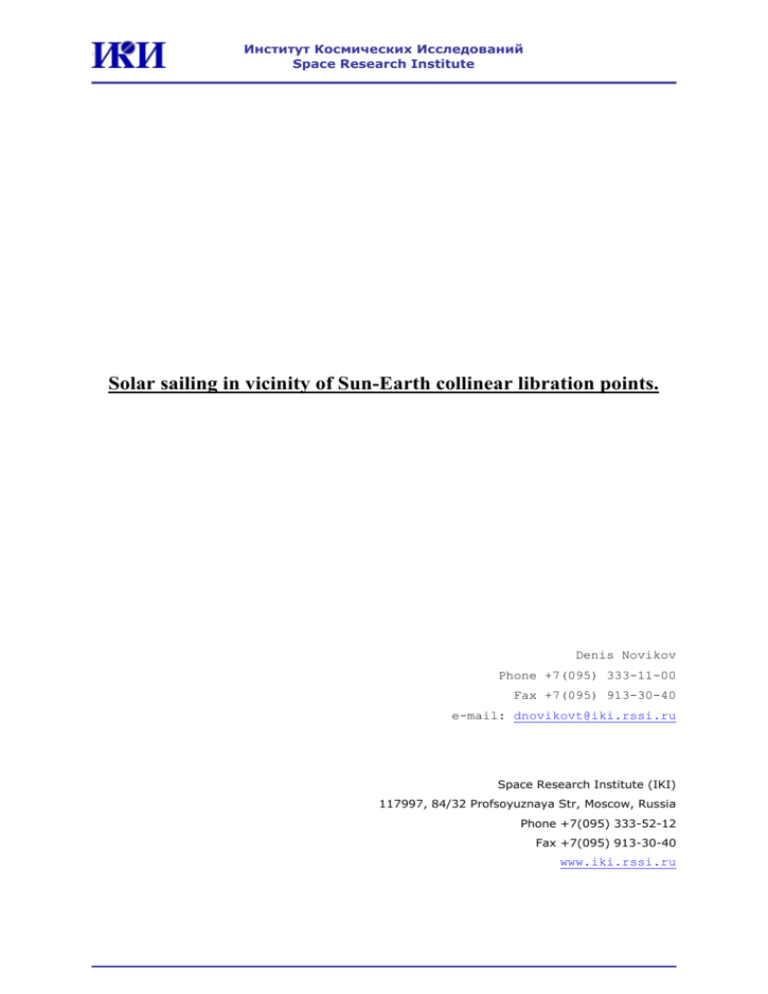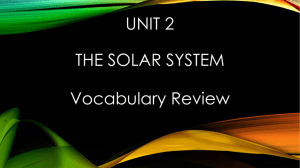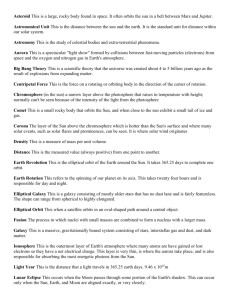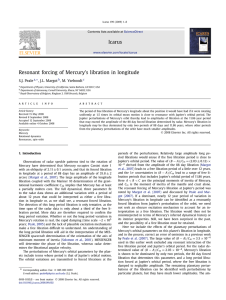Earth-Synchronous Heliocentric Orbital Motion Using Solar
advertisement

Институт Космических Исследований Space Research Institute Solar sailing in vicinity of Sun-Earth collinear libration points. Denis Novikov Phone +7(095) 333-11-00 Fax +7(095) 913-30-40 e-mail: dnovikovt@iki.rssi.ru Space Research Institute (IKI) 117997, 84/32 Profsoyuznaya Str, Moscow, Russia Phone +7(095) 333-52-12 Fax +7(095) 913-30-40 www.iki.rssi.ru Институт Космических Исследований Space Research Institute Abstraction. For space weather studies it is very effective to put spacecraft into vicinity of L1 libration point. With the use of solar sails it is possible to control the motion of the spacecraft including shift the orbit further from the Earth. The possibilities of this approach are considered and results are presented. Earth-Synchronous Heliocentric Orbital Motion Using Solar Sails Well known example of the Earth- Synchronous spacecraft (s/c) heliocentric orbital motion is the case when s/c is positioned in L1 or L2 solar-terrestrial libration points. In these cases s/c is moving around the Sun with the same period as the Earth being either 1.5 mln. km closer (L1) or further (L2) to the Sun than the Earth and situated on Sun-Earth line. It is possible because Earth in this case is decreasing (L1) or increasing (L2) the Sun gravity field acceleration to the extent required by necessity to keep orbital period of the s/c equal to Earth one. Similar effect can be reached by use of solar sails. Using them in the vicinity of L1 libration point one can reach additional decreasing effect of solar gravity acceleration thus allowing to shift s/c Earth-Synchronous position closer to the Sun than L1 point. Suppose we intend to shift s/c closer to the Sun than the Earth orbit of a radius by d distance keeping the same Earth heliocentric orbital angular rate . For motion along this more close to the Sun circular orbit the required heliocentric acceleration is to be: Wr 2 (a d ) . If s/c is positioned on Sun-Earth line then the acceleration produced by the Earth gravity field force is: WE E d2 , where is the Earth gravitational constant, the acceleration produced by Sun gravity field is: WS S (a d ) 2 , the required acceleration to be produced by solar radiation pressure is WP F S , m where F is solar radiation pressure, S - s/c cross-section area, m - s/c mass. DENIS NOVIKOV 2 Институт Космических Исследований Space Research Institute Then the formula is valid: 2 (a d ) S (a d ) 2 E d 2 F S . m Using the following values of parameters: S = 132712517, E = 398.6, a = 149597.81 tds. km, 2 a N F 4.5 10 2 (for full photons absorption), ad m 6 and the above formula one can calculate the required solar radiation acceleration Wr and required m/S ratio for solar sails. Some results of such calculations may be presented by the following table: d, Wr, tds km m/s2 m , kg/m2 S 1500 0 2000 -0.0001333 0.03468 2500 -0.0002306 0.02018 3000 -0.0003118 0.01502 4000 -0.0004560 0.01042 The case given in the above table supposes that solar radiation is fully absorbed by the solar sails, i.e. the reflectivity coefficient is equal zero. From effectiveness point of view it is the worst case. The best case is full reflectivity of sail surface, when acceleration produced by solar radiation pressure is two times higher. Accordingly the maximum allowed mass to cross-section area ratio is two times higher than given in the table figures. DENIS NOVIKOV 3 Институт Космических Исследований Space Research Institute Scheme of solar sail. Full ideal reflection. photons photons transparent liquid crystal film mirror reflecting layer Liquid crystal film with a mirror reflecting layer. Solar radiation pressure 2 a N F 9 10 2 ad m 6 Full absorption. photons fully non transparent liquid crystal film Solar radiation pressure 2 a N F 4.5 10 2 ad m 6 Fully diffused reflection. photons Solar radiation pressure 2 a N F 6 10 6 2 ad m DENIS NOVIKOV 4 Институт Космических Исследований Space Research Institute The orbit around the libration point. Methods and Tools to Launch spacecraft onto Trajectory in L1 Point Vicinity. It was shown that there are methods to launch s/c onto trajectory in vicinity of collinear solarterrestrial libration points L1, L2 using only one impulse on parking orbit. In this case the maximum amplitude of orbit around libration point is realized reaching 750 tds km for the cases when perigee of transfer orbit is in proximity of ecliptic plane and up to 1 mln. km in the other cases. DENIS NOVIKOV 5 Институт Космических Исследований Space Research Institute The injecting V impulse for all these cases is about 3200 m/s for 200 km altitude circular parking orbit. To form the near libration point orbit with lower amplitude one needs to apply additional impulse. This impulse reaches its maximum value equal 300 m/s when this amplitude is to be equal zero. The value of this impulse is linearly depending amplitude reaching zero value when amplitude is maximum value. There is alternative way to decrease the amplitude by use of Lunar gravity assist maneuver. Taking into account the small mass of the s/c it seems most attractive to use passenger or semi passenger mode of launch. High elliptic parking orbits can be considered for such approach. From list of such orbits those which are used for comparatively regular launches of dedicated payloads are worth full to be explored. Examples of the mentioned orbits are the ones for “Molniya” and “Oko” s/c. These orbits are high elliptical half-day period orbits. Despite big angle of its perigee-apogee lines with respect to the ecliptic plane (perigee is comparatively far from ecliptic plane) it is still possible to use them as intermediate parking orbits for injection s/c to transfer trajectory to libration points. Required V for injection s/c to transfer orbit is 680 m/s for the mentioned half-day period orbit. The other example of candidate parking orbit is geostationary transfer orbit. For this case V is 750 m/s. Advantage of this orbit is the fact that the perigee if the transfer orbit is close to the ecliptic plane for this case what allows applying Moon gravity assist maneuver for decreasing the near libration point orbit amplitude. Thus taking into account not excluded requirements to apply V impulses for construction zero-amplitude libration orbit and unavoidable correction maneuvers the total V is to be taken about 750+300+50= 1100 m/s. It means that for hydrazine as propellant with specific impulse 2200 m/s the mass of propellant is to be about 40 percent of s/c initial mass. DENIS NOVIKOV 6






